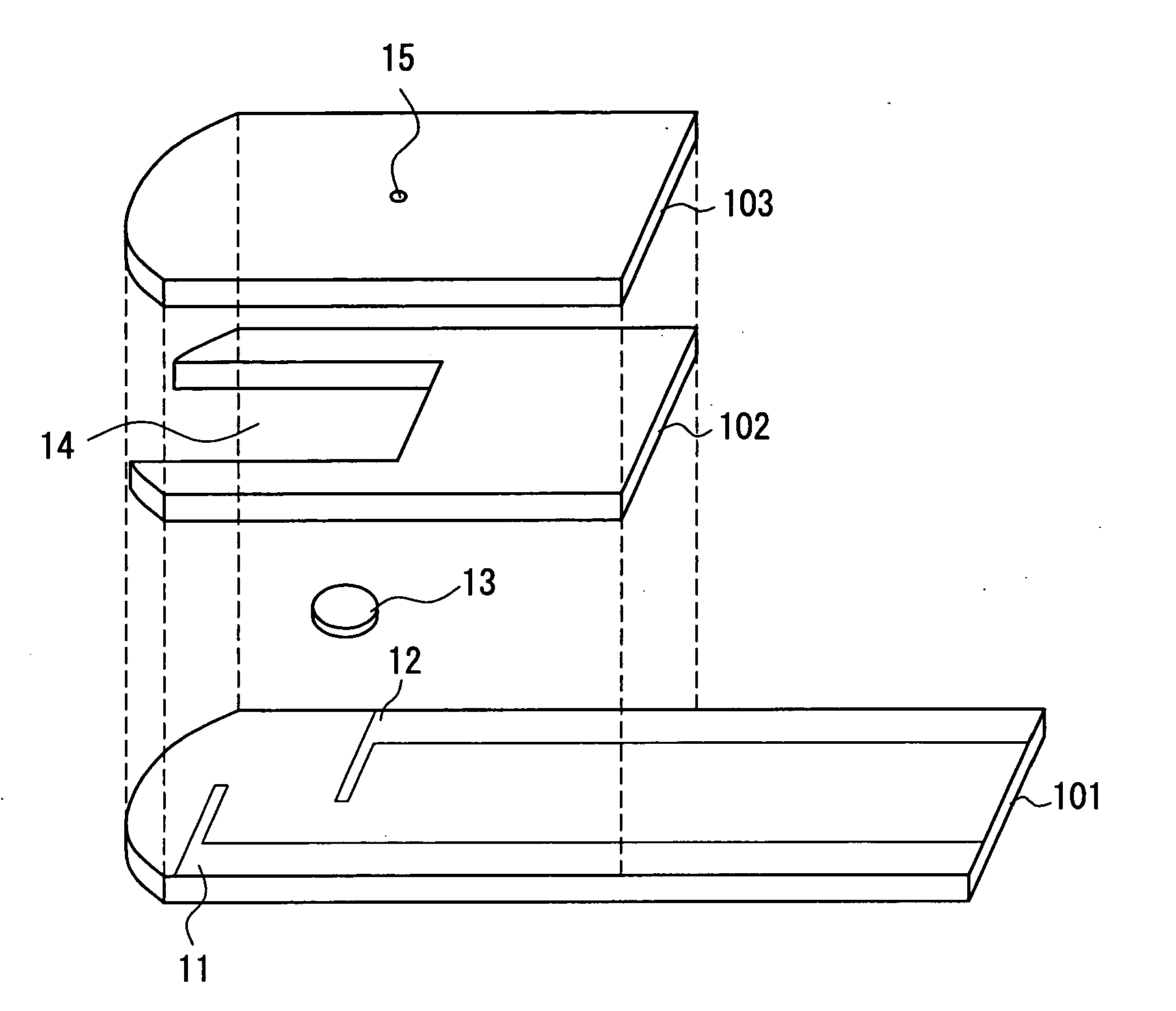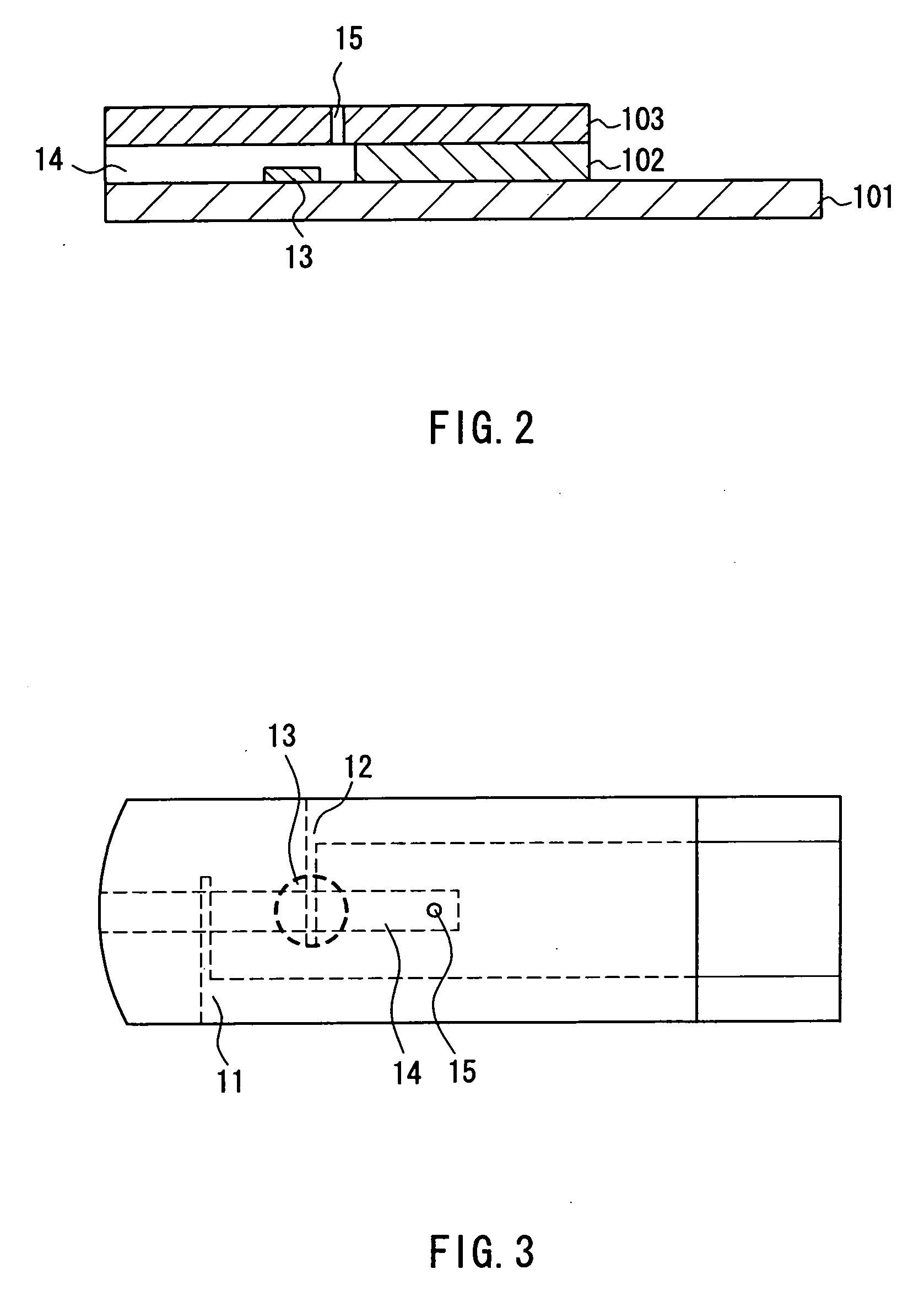Method of measuring hematocrit (hct), sensor used in the method, and measuring device
a technology of hematocrit and sensor, applied in the field of method of measuring hct, sensor used in the method, and measuring device, can solve the problems of long time, complicated operation, and difficulty in using a sensor, and achieve excellent measurement accuracy, high sensitivity, and easy measurement.
- Summary
- Abstract
- Description
- Claims
- Application Information
AI Technical Summary
Benefits of technology
Problems solved by technology
Method used
Image
Examples
example 1
[0071] A sensor having a configuration as shown in FIGS. 1, 2, and 3 was produced. In this sensor, a working electrode 11 was coated with CMC. On the other hand, a reagent solution prepared by dissolving potassium ferricyanide (amount: 60 mM) and taurine (80 mM) in a CMC aqueous solution (0.1 wt %) was dropped on a counter electrode 12 and then dried. The shortest distance between the electrodes was set to be at least 1.0 mm. On the other hand, three types of blood samples whose Hct values were adjusted so as to be 25, 45, and 65, respectively, were provided. With regard to each of these three blood samples, a current flowing between the electrodes of the sensor when a voltage of 2.5 V was applied for 3 seconds was measured using the sensor. The results are shown in the graphs of FIGS. 7A and 7B. FIG. 7A is a graph showing changes in response current (μA) over time during the application of the voltage (V), and FIG. 7B is a graph showing changes in difference in sensitivity (%) over...
example 2
[0074] In the present example, six types of sensors (2-1 to 2-6) were produced so that they were different from each other in the arrangement of a redox substance (potassium ferricyanide) with respect to a working electrode or a counter electrode, and the response current and the difference in sensitivity were measured using these sensors. Also, as sensors according to Comparative Example 3, three types of sensors (2-7 to 2-9) were produced so that they were different from each other in the arrangement of a redox substance (potassium ferricyanide) with respect to a working electrode or a counter electrode, and the response current and the difference in sensitivity were measured using these sensors. Note here that the above-described respective sensors were produced in the same manner as in Example 1 except for the arrangement of the redox substance and the distance between the electrodes (1.15 mm). Also note that the response current and the difference in sensitivity were measured i...
example 3
[0093] In the present example, the response current and the difference in sensitivity of a sensor were measured at various applied voltages in the range from 0.5 to 6.5 V. The sensor was produced in the same manner as in Example 1. Furthermore, the response current and the difference in sensitivity were measured in the same manner as in Example 1. The results of the measurement are shown in the graphs of FIGS. 19 to 31. In FIG. 19 to FIG. 31, FIGS. 19A to 31A are graphs each showing changes in response current (A) over time during the application of the voltage (V), and FIGS. 19B to 31B are graphs each showing changes in difference in sensitivity (%) over time during the application of the voltage (V).
[0094] As shown in FIG. 19, even when the applied voltage was 0.5 V, it was possible to detect the response current reflecting the Hct value. However, as shown in FIGS. 20 to 31, the response current could be measured still more definitely when the applied voltage was in the range fro...
PUM
| Property | Measurement | Unit |
|---|---|---|
| applied voltage | aaaaa | aaaaa |
| applied voltage | aaaaa | aaaaa |
| distance | aaaaa | aaaaa |
Abstract
Description
Claims
Application Information
 Login to View More
Login to View More - R&D
- Intellectual Property
- Life Sciences
- Materials
- Tech Scout
- Unparalleled Data Quality
- Higher Quality Content
- 60% Fewer Hallucinations
Browse by: Latest US Patents, China's latest patents, Technical Efficacy Thesaurus, Application Domain, Technology Topic, Popular Technical Reports.
© 2025 PatSnap. All rights reserved.Legal|Privacy policy|Modern Slavery Act Transparency Statement|Sitemap|About US| Contact US: help@patsnap.com



